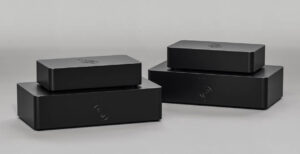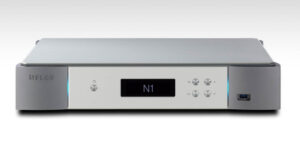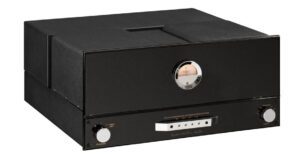
A few years ago, Krell stood at something of a crossroads. There had been a public and somewhat acrimonious split between the company founder and its new owners, and the ideas behind the brand were looking a little old-fashioned. It could have quietly sunk below the radar. Instead, we’re looking at Krell 2.0, at nu‑Krell, and the Vanguard integrated amplifier is exactly as its name suggests; leading that charge into the future of audio.
There’s a problem with change, though. It’s tempting for a company to throw the baby out with the bathwater. Change is good, but change for change’s sake isn’t. Fortunately, the Keepers of Krell decided to keep what is good, and only change what is needed to change, in part to keep abreast of 21st Century developments.
This means the amp is a blend of tried and trusted, and state-of-the-art. The tried-and-trusted part is all about the audio performance, with a Class A preamp, coupled to a beefy ‘iBias’ style power amplifier stage delivering 200W per channel into eight ohms, and doubling that load to 400W into four ohms. This is made possible thanks to a heavy 750VA toroidal transformer on one side of the chassis, and a healthy 80,000µF of reservoir capacitance, and noiseless fan-cooled heatsinks on the other.
Krell’s power amp stage is perhaps best described as a ‘sliding bias Class A’ design. The circuit continuously monitors the output stage, adjusting the bias on the fly instantaneously to accommodate the demands put upon it by the loudspeaker load. In theory at least, this means the Vanguard, and all its iDrive power amplifier bigger brothers, should be capable of delivering a performance without the crossover distortion inherent to any amplifier class that isn’t Class A, but without the ecologicially-challenging inefficiency that is entailed with those designs. Or, put simply, Class A sound without Class A heat and fuel bills. Vanguard doesn’t get much more than pleasantly warm in use, but the chassis bristles with ventilation holes all the same.
Regardless, the Krell Vanguard is the size of something like an Arcam integrated amp, but weighs as much as two and a bit Arcam integrated amps, and unless you are ready for that, it comes as something of a shock. OK, some perspective is in order: a shade under 18kg is as nothing when you recall the hernia-inducing 79.2kg of the Evolution 900e monos!
In standard Vanguard guise, the amp sports three single-ended RCA stereo inputs and one balanced XLR stereo pair. The blue fluro display on the front panel can be used to adjust (trim) input level and assign names to the inputs. It features a ‘Theater Throughput’ mode, and has the standard 3.5mm jacks and 12v trigger for use in traditional home automation systems. But it also comes with an Ethernet port as standard, designed for a more sophisticated external control. This means you can control everything through your Vanguard’s own home page, and in the unlikely event that anything should go wrong, it can send error logs to your dealer or Krell itself. This means diagnostics and potentially updates can be handled without the need for call outs or downtime.

The Vanguard as tested came in this standard guise, but there is an upgrade coming. The back panel has a removable panel, and an optional digital audio module can be installed. This will include USB, coaxial, and optical digital inputs, plus HDMI input and output ports. It also activates the front USB input for using USB sticks (I’d prefer that to come with a little rubber cover as standard, to prevent confusion, because in its standard guise, the Vanguard doesn’t speak USB at all). The digital module will expand the functions of the Ethernet port to support music streaming, controlled by the company’s dedicated iOS and Android apps. Finally, the module adds apt‑X Bluetooth connectivity. However, to reiterate, this module is currently in late design and was not available in time for review, so I cannot speak to how it performs or functions.
Despite the Ethernet connectivity and digital module, I don’t think the Vanguard is ‘future-proofed’, because ‘future-proofed’ is functionally impossible. No‑one would have guessed in 2000 that the audio world of 15 years hence would be made up of streamed music and LP, so trying to imagine what we will be playing in five, 10, or 20 years from now is an exercise in pointlessness. So, let’s quietly lock ‘future proofed’ away in the cliché dungeon. However, it’s entirely possible the Vanguard will still be making music for someone in five, 10, or 20 years from now. The secret is making the product robustly ‘now proof’ rather than crystal ball gazing. And the Vanguard is about as ‘now proof’ as it is possible to get.
If you have been following Krell’s recent output, the Vanguard is easy to place; it’s what happens if you put an Illusion preamplifier and an iBias power amplifier in the same room, buy them dinner, maybe some chocolates and a dozen roses, line up a few rom‑coms, and play some Barry White records. Joking aside, Vanguard can happen because Krell is switching over from predominantly discreet components to surface mount devices, which in the process makes the whole amplifier considerably smaller.
Krell has undergone a change of tonal balance recently, and the Vanguard reflects that shift. The company’s sound has moved from lush, through stark, and now into a presentation that encompasses modern recording techniques. Edge-of-the-seat dynamic range and a sound so forward it went zinging past your ears is not on the Vanguard’s books, and neither is the Class A fluidity of the original KSA‑50. Instead, we have something that meets in the middle. And I suspect that’s a sound very much in line with the way audio is going.

Despite the sliding bias iDrive power amp stage and the Class A preamplifier, this is not Class A sound in the traditional sense. It has the upper end openness and lack of glare typically found with Class A, but it manages to also do this without the ‘rose tinted’ nature sometimes associated with that amp class. It’s a darker, more controlling than controlled approach to the sound. It’s like the good ol’ grip of earlier Krell amps is retained, yet with a sound more even-toned and approachable. This makes the Vanguard slightly less detail-oriented and possessed of an endlessly large soundstage, making it the audiophile’s friend, but instead makes it more able to support a wider range of music. There are two albums back-to-back in my collection Somethin’ Else, by Cannonball Adderley [Blue Note] and Don’t Hear It… Fear It by Admiral Sir Cloudsley Shovell [Rise Above]. One is a jazz classic from the late 1950s, the other psychedelic metal from three years ago. One is prime audiophile fodder, the other loud, shouty, and fun. Typically, a system that is detailed, dynamic, and honest enough to play the former makes the latter sound awful, and systems that make the latter sound good make the former sound bland and uninspiring. The Vanguard is one of that rare group that sits between the two poles – making well-recorded music come to life, and yet not exposing the limitations of compressed and compromised audio in the process.
I can see Vanguard’s abilities with non-audiophile music potentially putting off the old guard, but the reality is the Krell manages to make good sounding recordings sound very good indeed. There can’t be much more ‘audiophile’ than ‘East Carolina Woman’ from Doug MacLeod’s There’s A Time album [Reference Recordings] and the Krell manages to convey a fine sense of space and detail, and a complete absence of background hash. It also has that sense of dynamic authority and ‘real’ stentorian bass, that may seem like it wouldn’t be an issue in an acoustic blues album, but it roots the sound in solid, almost visceral, space. As discussed, the presentation is different to earlier Krell, more rounded and perhaps a trifle darker than before, but this means there’s more focus across the board than that exciting top end of old.
The Vanguard is, however, more fleet-footed than I expected. It doesn’t impose or enforce a beat, but it does do very well handling music that bounces along well, such as ‘Carolina Rain’ from Ryan Adams’ 29 [Lost Highway]. Once again, this comes from a solid foundation of bass, but not so authoritative that it undermines the sense of swing inherent to the track.
I did find myself playing slightly less classical music than usual, which was odd because the Krell Vanguard was extremely good at portraying strings and especially solo piano. Nevertheless, I found myself liking Bach as an intellectual pursuit where I enjoyed and found myself tapping my foot along to Fat Albert Rotunda by Herbie Hancock [Warner]. I also found the overall balance of albums I took in over the time it sat in my system tended away from classical slightly more than usual. Once again, I’m somewhat bemused by this, as I found its classical performance extremely good. Maybe it’s me, and I’m not in as much of a classical mood at this time, but it just seemed that I tended to pick out jazz and especially rock more than I did classical.
Let’s be frank about the power output. Krell has been demonstrating the Vanguard in a ‘fighting above it’s weight’ style, partnering it with the kind of loudspeakers never normally associated with ‘entry-level’ integrated amp (even if it’s entry-Krell), and for good reason. The amp can take it. OK, what more power brings is even greater headroom and an ability to play Mahler and Metallica at full-on levels. And also, the process of squeezing a quart into a pint pot means the Vanguard doesn’t have the same effortless ability to shrug in the face of impossible loudspeaker loads. But, unless you are playing music in a soundproofed bunker, or attempting to drive a super inefficient loudspeaker with an impedance plot that borders on cruel and unusual punishment for an amplifier, the Vanguard’s ‘run out of steam’ point is beyond sensible limits. If you do push it to the point where things get ugly, it has a tendency to go brash before it goes into clipping, but given I mostly used the Vanguard with the Wilson Duette 2 loudspeakers and to get the combination going into clipping is deafeningly loud, I don’t think this is a significant grumble.
The Vanguard’s strength is its flexibility. It’s the first audio amp in a long time that I happily hooked up to a TV set and just watched a few movies. Far from being some kind of audiophile no‑go area, it made me realise that vocal articulation and dynamic range here were very impressive. YouTube music isn’t quite so well served, but I suspect that comes down to the format, not the amp.
That this is a good amplifier is a given. It comes from ‘a good family’ and that’s clear from the listening. But more pertinently, the Krell Vanguard is an important amplifier, and not simply for Krell. There’s a little phrase on the Vanguard webpage that could be easily overlooked, but in fact best describes the rationale for this amplifier. That phrase is “living-room-friendly”. Note: “living” room, not “listening” room. This isn’t ‘man cave’ Krell, it’s Krell for the family. And that is a very good thing. Yes, it means you’ll be sharing your listening time with others, and yes, that optional Bluetooth connection means sometimes you’ll be hearing your children’s music, or even playing music as a background for a party at home. But in the process, you get to hand back your ‘audio hermit’ badge. Maybe, just maybe, that might make audiophiles seem a shade less curmudgeonly and weird, and maybe we’ll be able to ignite that passion for music and the sound it makes in others. Ultimately, Vanguard is tomorrow’s Krell, today.
Technical Specifications
Type: integrated solid‑state amplifier
Audio inputs: 1x balanced XLR stereo pair, 3x single‑ended RCA stereo pair
Audio outputs: 2x speaker outputs via WBT gold‑plated binding posts
Control inputs: 1x 3.5mm remote IR detector, 1x 3.5mm 12VDC trigger
Control output: 1x 3.5mm programmable 12 VDC trigger, RJ45 Ethernet
Power output: 200 W RMS per channel at 8 Ω, 400 W RMS per channel at 4 Ω
Input impedance: 95 kΩ (balanced), 47.5 kΩ (single‑ended)
Frequency response: 20Hz to 20kHz +0, –0.01 dB, <2 Hz to 150 kHz +0, –3 dB
THD: <0.015% at 1 kHz, at 200 W, 8 Ω load
Signal‑to‑noise ratio: >97 dB, “A”‑weighted
Gain: 48 dB
Optional Digital Module Specs: Coaxial and HDMI inputs support PCM up to 24‑bit/192kHz. optical input up to 24‑bit/96kHz; USB and Network streaming support MP3, AAC, WMA, WAV(PCM), FLAC, ALAC up to 192kHz; Bluetooth streaming supports A2DP, AVRCP, HFP, HSP
Dimensions (W×H×D): 434×105×445mm
Weight: 17.7kg
Price: £4,500
Manufacturer: Krell Industries LLC
URL: www.krellonline.com
Distributed by: Absolute Sounds
Tel: +44(0)208 971 3909
Tags: FEATURED
By Alan Sircom
More articles from this authorRead Next From Review
See all
Reiki Audio SuperSwitch Master Pro + Servant Pro
- Mar 27, 2024

Melco Audio N1-S38 music server
- Mar 27, 2024

Focal Utopia 2022 headphones
- Mar 27, 2024











